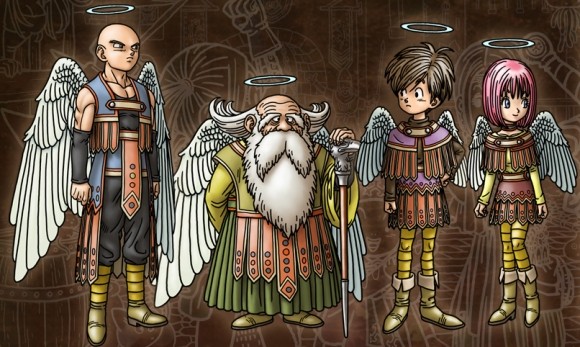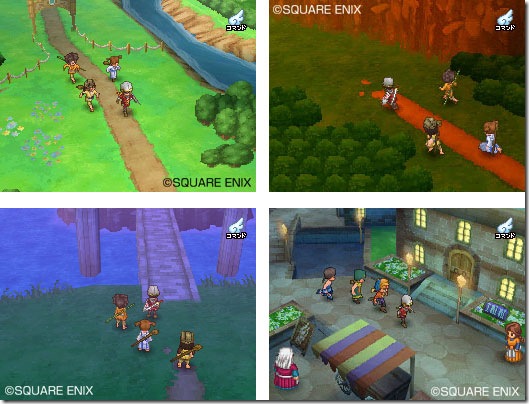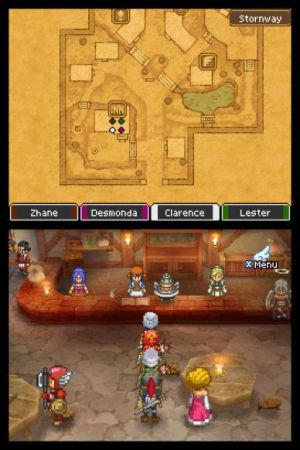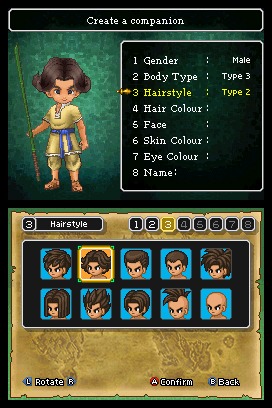Genuinely charming art and music direction; impressive localization; ridiculously robust post-game material
Slight slowdown sometimes; disappointing local-only multiplayer implementation
Before playing Dragon Quest IX: Sentinels of the Starry Sky, the only Dragon Quest game I had ever played was Dragon Warrior Monsters (GBC, 1998)– a game that wasn’t even developed by Enix, but rather by the enigmatic Tose. That’s not to say that I didn’t like the concept of Dragon Quest– in fact, I spent hundreds of hours on Dragon Warrior Monsters, breeding that perfect team, getting those perfect stats, and when it came right down to it, Dragon Quest should have been the kind of game that appealed to me most. But for some reason, until Dragon Quest IX, despite my somewhat unhealthy obsession with incessant level-ups and constant monster-hunting– both of which revealed themselves in other role-playing games –I had yet to really immerse myself in one of Dragon Quest‘s numbered games.
I know now that this is a tragedy. If any of those other Dragon Quest games are as endorphin-inducing or as adrenaline-pumping as Dragon Quest IX, well, I’ve definitely missed out on a good chunk of a lively series. My Dragon Quest IX cartridge, though I’ve had it since launch date back in July, has stayed in my DS Lite ever since.

Akira Toriyama’s distinctive art style returns to Dragon Quest IX.
So many people describe games like those in the Tetris or Pokémon series as games they can’t put down– and it’s pretty easy to see why. Tetris and Pokémon, after all, are worldwide phenomenons that owe their success to pure, simple gameplay. (Or, perhaps in Pokémon’s case, impressive advertising campaigns.) Meanwhile, people rarely laud role-playing games like the Final Fantasy or Dragon Quest games in the same way– usually it’s just a few remarks about how wonderful the story is, or how great the battle system is. Thankfully, Dragon Quest IX stands out exactly in this regard: from the very beginning, the game locks you into its unfurling story, keeping you playing with a healthy dose of charming art direction from Akira Toriyama and absolutely stellar music from Koichi Sugiyama, all wrapped up in Yuji Horii’s deceptively tiny package. And like Tetris or Pokémon, Dragon Quest IX hooks gamers with a simplicity often overlooked in role-playing games– a simplicity that, after Dragon Quest IX, gamers may be loathe to forgo on their next role-playing fix.
 Dragon Quest IX‘s story is perhaps the greatest indicator of its simplicity. Starting off, you play as an unnamed angel who flitters around trying to help people in your assigned town. Of course, it’s not rainbows and butterflies for long, as an unknown force knocks you out of the sky, causing you to fall to the mortal realm, and thus have to help people as though you were (perish the thought) one of them. And so, though your angelic self will spend most of the time wandering around, slaying monsters and gathering experience points, you’ll also run into every possible permutation of human nature, including scientific geniuses marred by reclusiveness, power-hungry politicians hoarding all the money they can see and little girls who want nothing more than to find their families. Though none of these plotlines seem to intersect with each other at first, giving the impression that you’re not actually making any headway into any overarching story, all this world-trekking and people-helping eventually coalesces, in true role-playing game fashion, into one surprisingly robust story. It’s only then that each little vignette of each scientist or politician or child not only makes sense as a whole, but also hits home in a very, very big way.
Dragon Quest IX‘s story is perhaps the greatest indicator of its simplicity. Starting off, you play as an unnamed angel who flitters around trying to help people in your assigned town. Of course, it’s not rainbows and butterflies for long, as an unknown force knocks you out of the sky, causing you to fall to the mortal realm, and thus have to help people as though you were (perish the thought) one of them. And so, though your angelic self will spend most of the time wandering around, slaying monsters and gathering experience points, you’ll also run into every possible permutation of human nature, including scientific geniuses marred by reclusiveness, power-hungry politicians hoarding all the money they can see and little girls who want nothing more than to find their families. Though none of these plotlines seem to intersect with each other at first, giving the impression that you’re not actually making any headway into any overarching story, all this world-trekking and people-helping eventually coalesces, in true role-playing game fashion, into one surprisingly robust story. It’s only then that each little vignette of each scientist or politician or child not only makes sense as a whole, but also hits home in a very, very big way.
But story shouldn’t be your main preoccupation in Dragon Quest IX— in fact, developer Level-5 [Dark Cloud (PS2, 2001), Professor Layton and the Curious Village (DS, 2008)] made sure to throw so much into this game that story almost feels superfluous in the process. Once it’s unlocked early in the game, for example, players can spend their time collecting various ingredients to throw in an alchemy pot, which will transform those items into things like armor, weapons or potions– most of which invariably turn out to be quite powerful –and considering the sheer number of recipes possible for alchemy, players will be sure to spend an inordinate amount of time trying to make them all. Meanwhile, Level-5’s also taken a bold new step for the Dragon Quest series by letting players customize their characters, MMORPG-style, in unprecedented ways. Want to make a team of Dragon Ball Z-esque fighters? You definitely can. Sailor Moon wannabes? Those too. Combine this instant visual validation with the clothing choices the alchemy system produces, and you’ve got an endless addiction on your hands. Of course, you can also just buy your armor from the local town shops, but considering the game encourages nigh-random experimentation– each of your characters has, along with normal ones like Magical Mending or Resilience, a Style stat that determines the chance for monsters to be distracted (I kid you not) by your haute couture –buying just things like Iron Helms or Steel Shields may not be such a great idea. Just as Level-5 puts its best new steps forward for Dragon Quest IX, so does Level-5 encourage gamers to try some crazy things for themselves– and, really, it turns out to be great fun.
This fun in experimentation further reveals itself with the wonderful English localization of Dragon Quest IX, which, though tight-knit and focused, does not give up any chances to be lighthearted. While most role-playing games– especially Japanese ones –fill their cities with non-player characters that do nothing more than point you in a general direction to gather this or that, Dragon Quest IX‘s towns are filled with memorable characters that really do capture your heart. Witty dialogue, almost Mark Twain-esque phonetic dialect work and, of course, hilarious (and often facepalm-worthy) one-liners make talking to even the most mundane NPCs a joy– without sacrificing vital information. (I won’t even begin to discuss the hundreds of puns in the game that the localization team had way too much fun writing.) Though by and large role-playing games have devolved to the point where players mindlessly go through towns just looking for weapons and armor, not even remembering the names of the places they’ve been through, players can actually identify Dragon Quest IX‘s towns and cities not by layout (though they’re certainly creative), but by the types of people who live there, as well as, refreshingly, their dialects.

Time was you could travel the world without getting distracted by fully developed cities like these.
But of course, even Dragon Quest IX has to adhere to some role-playing game standards, foremost among them a battle system that actually makes players want to battle monsters. Fortunately, what seems to be a bit of a difficult task for other games (the constant shifting of battle systems in Final Fantasy games makes it pretty clear that gamers aren’t content with just the average “press A mindlessly” system) is done flawlessly in Dragon Quest IX. To start with, Level-5 offers the usual role-playing game turn-based battle system, allowing characters to attack, cast spells, use items and perform skills– the latter of which is where the real meat of the system works out. By leveling up your characters in various classes, from your starting class as Minstrel to hardcore ones like Gladiator, characters get skill points that they can use in a number of disciplines. These disciplines include weapon masteries (increasing proficiency in styles ranging from swordplay to fisticuffs) and class masteries (increasing stats relevant to a specific class), and with each bundle of skill points deposited into each discipline comes either increased stats or new skills. Needless to say, such numerical manipulation isn’t unheard of in video games– even the original Diablo (PC, 1997) did a version of this with its play-as-you-want stat and skill manipulation– but considering the sheer number of disciplines in Dragon Quest IX, as well as the almost Pokémon-esque “gotta learn ’em all” fashion of the skills, Dragon Quest IX certainly knows how to make this otherwise-cookie-cutter mechanic at least feel fresh.
 And considering the post-game potential of Dragon Quest IX, that freshness is certainly necessary. After the story ends in Dragon Quest IX and you’ve more or less saved the world, you’ll delve into the real meat and potatoes of the actual game. Of course, this is a little odd for a role-playing game– usually, replay value exists in the form of “New Game +”, as in Tales of Symphonia (GCN, 2004), or trying to get all the alternate endings, as in Chrono Trigger (SNES, 1995). Rarely do we ever have a game like Dragon Quest IX, whose replay value exists within the very game you started off with. Various non-player-characters freely distribute MMORPG-style quests, which further both the main storyline and unrelated side stories, and considering there are well over a hundred quests in the game to start with, with even more distributed weekly via Nintendo Wi-Fi Connection– many of which are hidden among the world’s least visited locales, and even more of which require significant time investment to finish –finishing each one will take quite some time. Though some quests do seem like a chore (also borrowing from the MMORPG idea of quests), involving getting five of these random objects or finishing off this obscure monster with this ridiculously weak weapon, for the most part quests are enjoyable, if not simply because their rewards are so good (usually) and the characters who give them are just so hard to hate.
And considering the post-game potential of Dragon Quest IX, that freshness is certainly necessary. After the story ends in Dragon Quest IX and you’ve more or less saved the world, you’ll delve into the real meat and potatoes of the actual game. Of course, this is a little odd for a role-playing game– usually, replay value exists in the form of “New Game +”, as in Tales of Symphonia (GCN, 2004), or trying to get all the alternate endings, as in Chrono Trigger (SNES, 1995). Rarely do we ever have a game like Dragon Quest IX, whose replay value exists within the very game you started off with. Various non-player-characters freely distribute MMORPG-style quests, which further both the main storyline and unrelated side stories, and considering there are well over a hundred quests in the game to start with, with even more distributed weekly via Nintendo Wi-Fi Connection– many of which are hidden among the world’s least visited locales, and even more of which require significant time investment to finish –finishing each one will take quite some time. Though some quests do seem like a chore (also borrowing from the MMORPG idea of quests), involving getting five of these random objects or finishing off this obscure monster with this ridiculously weak weapon, for the most part quests are enjoyable, if not simply because their rewards are so good (usually) and the characters who give them are just so hard to hate.
As if quests weren’t enough after you’ve saved the world, Dragon Quest IX also introduces treasure maps to the series. Though you get treasure maps during the course of the game– maps that pinpoint specific locations with sprawling dungeons and indomitable treasure-holding bosses– and do get the chance to garner some pretty rad treasure, the best treasure requires a certain level of dedication. Without leveling your characters to ridiculous levels again and again in different classes, you won’t be able to get the very best treasure maps. And of course, without taking the time to alchemize the very best weapons and armor, your characters may well fall against the bosses guarding those maps. (In fact, general consensus amongst Dragon Quest IX players is to not even attempt the first treasure map you get until a few levels later– even though its boss is the easiest among all grotto bosses.) Like the class and skill systems of Dragon Quest IX, completing each successive grotto provokes an addiction that grows steadily more difficult to shake off. (I knew I had a problem when I stayed up late at night staring at the GameFAQs forums for Dragon Quest IX, learning about item drop manipulation and grotto map generators.) And considering that players can share their best treasure maps with each other via Nintendo’s “Tag Mode”, a la Nintendogs or Animal Crossing: Wild World, it’s probably a good idea to go to video game conventions or similar events with your Dragon Quest IX cartridge, if not simply because getting more maps means getting more treasure. (Or more chances of being completely demolished by powerful bosses.)
Of course, if alchemy, quests and treasure maps seem too much to do for the everyday Dragon Quest IX player, that’s probably because it is. You can, if you want, complete the main storyline in around forty to sixty hours (already a rather huge number for a DS game), if you don’t do anything other than going straight to each town and completing only the mandatory quest lines. And completing a good amount of alchemy and side-quests does make the main storyline a bit too easy, if only because the weapons and armor you get from these side projects will far outclass anything you’ll obtain in the main storyline. (One climactic event in the game seems carefully crafted to impress the average player, since the items given you get during the scene are clearly meant to be powerful, but if you’ve spent much time alchemizing at all, those items will be obsolete the moment they go into your inventory.) Many players will even drop Dragon Quest IX for another game once they’ve beaten the main storyline. But Level-5 has done a great job constructing Dragon Quest IX to appeal to both addicts enthusiasts and casual players– if there’s one role-playing game out there that you can play however you want, Dragon Quest IX is it.
 Unfortunately, this doesn’t quite seem to apply to the multiplayer, which, though fun, is grievously limited. With multi-card, local play, players can join each other’s parties and follow each other along on quests, storylines, or even grottoes. However, this is at the expense of kicking out valued party members to make room for visitors, leaving their experience points lagging far behind in extended multiplayer sessions. Furthermore, progress made in the host’s cartridge will not carry over to visitors, causing players to have to finish quests and deal with storylines all over again once they leave the session. Though this isn’t much of a problem post-game, when dedicated players are at the level cap anyway and don’t have that many quests to do, it’s frustrating during the actual storyline. Post-game, however, since players actually get a copy of the map and treasures that drop off grotto bosses, Dragon Quest IX‘s multiplayer becomes much more viable– though often players will still go solo, if not only because they’ll have more control over each and every move their characters make against a boss. (Although, it’s still fun to see what kinds of characters your friends come up with– the customization options allow for myriad variations.)
Unfortunately, this doesn’t quite seem to apply to the multiplayer, which, though fun, is grievously limited. With multi-card, local play, players can join each other’s parties and follow each other along on quests, storylines, or even grottoes. However, this is at the expense of kicking out valued party members to make room for visitors, leaving their experience points lagging far behind in extended multiplayer sessions. Furthermore, progress made in the host’s cartridge will not carry over to visitors, causing players to have to finish quests and deal with storylines all over again once they leave the session. Though this isn’t much of a problem post-game, when dedicated players are at the level cap anyway and don’t have that many quests to do, it’s frustrating during the actual storyline. Post-game, however, since players actually get a copy of the map and treasures that drop off grotto bosses, Dragon Quest IX‘s multiplayer becomes much more viable– though often players will still go solo, if not only because they’ll have more control over each and every move their characters make against a boss. (Although, it’s still fun to see what kinds of characters your friends come up with– the customization options allow for myriad variations.)
A few other problems exist in Dragon Quest IX as well, though they’re simply annoying rather than game-breaking. Implementation of the touch screen is shoddy at best, as controlling movement with the stylus blocks the screen and selecting menu options requires an annoyingly undetectable double-tap of the stylus. The game also experiences some noticeable slowdown when heading into towns with a large amount of characters, especially since your characters are rendered three-dimensionally while most sprites are two-dimensional, and text speed is never quite quick or manageable enough. (The first time you talk to her, the bank teller will introduce the bank’s services to you through four or five text boxes, which is understandable. What isn’t, though, is why she continues to do this each and every time you talk to her, making it agonizing to make an oft-necessary deposit or withdrawal.) Again, however, this may just be nitpicking– though annoying, these bits don’t actually influence gameplay in any significant ways.
Coupled with its simple story and addicting post-game play, one of the greatest triumphs of Dragon Quest IX is that it manages to be a serious role-playing game without taking itself too seriously. Considering the puns and often ridiculous dialects in the game’s localization, Dragon Quest IX can often seem like a clownish, decidedly non-epic game– one that many gamers may find at best pleasantly different and at worst downright infuriating. But the localization’s actually perfectly in line with Level-5’s vision. Though it’s certainly good at pleasing level-grinders and obsessive treasure hunters, what with its grottoes and alchemy, Dragon Quest IX doesn’t seem to have aimed directly at the hardcore gamer crowd. In fact, from its charming graphics and music to its endearing plotline, Dragon Quest IX is clearly meant for people who just happen to enjoy video games, playing them as simple pleasures, rather than complicated drudgery. It’s a game that aims to please– and certainly pulls it off.




 ShareThis
ShareThis







I’m glad you touched on the liveliness of the towns and cities. Many reviewers fail to mention how much charm and character there is instilled into each and every place. I constantly found myself wondering what my next destination would be like and whom I would meet.
I’m also happy to see you enjoyed the game as much as me.